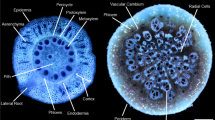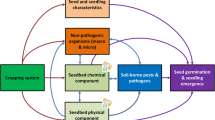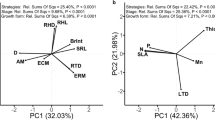Abstract
The salt marsh cord grass,Spartina alterniflora Loisel., occurs in markedly distinct short and tall growth forms. Both forms have the same number of chromosomes, although polyploidy is well established in the genus. Previous studies have shown that height is primarily affected by nitrate availability and environmental stresses such as increased soluble salt concentrations. These studies have shown that, within a marsh, height differences cannot be attributed to genetic, chromosomal differences or electrophoretic banding.
However, more subtle genetic differences may be involved. Other studies suggest that between marshes,S. alterniflora, in response to a latitudinal gradient on the Atlantic coast, has evolved ecotypes differing in height, color and flowering period. This review paper points out that plant height inS. alterniflora may be determined by a combination of environmental and genetic factors.
Similar content being viewed by others
Literature Cited
Adams, D. A. 1963. Factors influencing vascular plant zonation in North Carolina salt marshes.Ecology 44:445–456.
Ahmad, I., andS. J. Wainwright. 1977. Tolerance to salt, partial anaerobiosis, and osmotic stress inAgrostis stolonifera.New Phytol. 79:605–612.
Anderson, C. M. 1977. Cattail decline at Farmington Bay Waterfowl Management Area.Great Basin Nat. 37:24–34.
Anderson, J. L., andA. D. Bradshaw. 1966. Evolution in closely adjacent plant populations. II.Agrostis stolonifera in maritime habitats.Heredity 21:649–664.
Benson, J. S., B. L. Haines, andE. L. Dunn. 1977. Simulated tidal effects on height forms ofSpartina alterniflora Loisel.Bull. Ecol. Soc. Amer. 58:10.
Bradshaw, A. D. 1959. Population differentiation inAgrostis tenuis Sibth. I. Morphological differentiation.New Phytol. 58:208–227.
— 1960. Population differentiation inAgrostis tenuis Sibth. III. Populations in varied environments.New Phytol. 59:92–103.
— 1965. Evolutionary significance of phenotypic plasticity in plants.Adv. Genet. 13:115–155.
Broome, S. W., W. W. Woodhouse, Jr., andE. D. Seneca. 1975a. The relationship of mineral nutrients to growth ofSpartina alterniflora in North Carolina. I. Nutrient status of plants and soils in natural strands.Proc. Soil Sci. Amer. 39:295–301.
———. 1975b. The relationship of mineral nutrients to growth ofSpartina alterniflora in North Carolina. II. The effects of N, P, and Fe fertilizers.Proc. Soil Sci. Amer. 39:301–307.
Church, G. L. 1940. Cytotaxonomic studies in the GramineaeSpartina, Andropogon andPanicum.Amer. J. Bot. 27:263–271.
de Silva, M. W. R. N., andE. M. Burrows. 1973. An experimental assessment of the status of the speciesEnteromorpha intestinalis (L.) Link andEnteromorpha compressa (L.) Grev.J. Mar. Biol. 53:895–904.
Gallagher, J. L. 1975. Effect of an ammonium nitrate pulse on the growth and elemental composition of natural stands ofSpartina alterniflora andJuncus roemerianus. Amer. J. Bot. 62:644–648.
Gregor, J. W. 1946. Ecotypic differentiation.New Phytol. 45:254–271.
Haines, B. L., andE. L. Dunn. 1976. Growth and resource allocation responses ofSpartina alterniflora Loisel. to three levels of NH4−N, Fe, and NaCl in solution culture.Bot. Gaz. 137:224–230.
Harrison, D. 1975. Patterns in Biology. John Wiley and Sons, Inc., New York. 250 p.
Huskins, C. L. 1931. The origin ofSpartina townsendii.Genetica 12:531–538.
Longstreth, D. J., andB. R. Strain. 1977. Effects of salinity and illumination on photosynthesis and water balance ofSpartina alterniflora Loisel.Oecologia (Berl.) 31:191–199.
MacArthur, R. H., andJ. H. Connell. 1966. The Biology of Populations. John Wiley and Sons, Inc., New York. 200 p.
Marchant, C. J. 1963. Corrected chromosome numbers forSpartina × townsendii and its parent species.Nature 199:929.
— 1977. Hybrid characteristics inSpartina × neyrautii Fouc., a taxon rediscovered in northern Spain.Bot. J. Linn. Soc. 74:289–296.
McNaughton, S. J. 1966. Ecotype function in theTypha community-type.Ecol. Monogr. 36:297–325.
— 1970. Fitness sets forTypha.Amer. Nat. 104:337–342.
— 1974. Developmental control of net productivity inTypha latifolia ecotypes.Ecology 55:168–172.
—,T. C. Folsom, T. Lee, F. Park, C. Price, D. Roeder, J. Schmitz, andC. Stockwell. 1974. Heavy metal tolerance inTypha latifolia without the evolution of tolerant races.Ecology 55:1163–1165.
Mendelssohn, I. A. 1978a. Eco-physiological aspects of the height forms ofSpartina alterniflora in North Carolina: Nitrogen nutrition and soil waterlogging. Ph.D. Dissertation, North Carolina State University. 142 p.
Mendelssohn, I. A. 1978b. The influence of soil drainage on the growth of salt marsh cordgrassSpartina alterniflora in North Carolina. Unpublished manuscript submitted toEstuarine Coastal Mar. Sci.
Mettler, L. E., andT. G. Gregg. 1969. Population Genetics and Evolution. Prentice-Hall, Inc., New Jersey. 212 p.
Mooring, M. T., A. W. Cooper, andE. D. Seneca. 1971. Seed germination response and evidence for height ecophenes inSpartina alterniflora from North Carolina.Amer. J. Bot. 58:48–55.
Nestler, J. 1977. Interstitial salinity as a cause of ecophenic variation inSpartina alterniflora.Estuarine Coastal Mar. Sci. 5:707–714.
Parrondo, R. T., J. G. Gosselink, andC. S. Hopkinson. 1978. Effects of salinity and drainage on the growth of three salt marsh grasses.Bot. Gaz. 139:102–107.
Redfield, A. C. 1972. Development of a New England salt marsh.Ecol. Monogr. 42:201–237.
Ricklefs, R. E. 1973. Ecology. Chiron Press, Massachusetts. 861 p.
Roberts, D. T., R. S. Warren, andW. A. Niering. 1977. Soil nitrogen, iron and salinity and the height forms and distribution ofSpartina alterniflora on Connecticut tidal marshes.Bull. Ecol. Soc. Amer. 58:10.
Salisbury, F. B., andC. Ross. 1969. Plant physiology. Wadsworth Publishing Company, Inc., California. 747 p.
Seneca, E. D. 1974. Germination and seedling response of Atlantic and Gulf Coasts populations ofSpartina alterniflora.Amer. J. Bot. 61:947–956.
Shea, M. L. 1977. Photosynthesis and photorespiration in relation to phenotypic forms ofSpartina alterniflora. Ph.D. Dissertation, Yale University. 64 p.
—,R. S. Warren, andW. A. Niering. 1975. Biochemical and transplantation studies of the growth form ofSpartina alterniflora on Connecticut salt marshes.Ecology 56:461–466.
Stalter, R., andW. T. Batson. 1969. Transplantation of salt marsh vegetation, Georgetown, South Carolina.Ecology 50:1087–1089.
Stebbins, G. L. 1950. Variation and Evolution in Plants. Columbia University Press, New York. 643 p.
Suda, J. R., R. R. Sharitz, andD. O. Straney. 1977. Morphological aberrations inTypha populations in a post-thermal aquatic habitat.Amer. J. Bot. 64:570–575.
Sullivan, M. J., andF. C. Daiber. 1974. Response in production of cord grass,Spartina alterniflora to inorganic nitrogen and phosphorus fertilizer.Chesapeake Sci. 15:121–123.
Turesson, G. 1922. The genotypic response of the plant species to the habitat.Hereditas 3:211–350.
Valiela, I., andJ. M. Teal. 1974. Nutrient limitation in salt marsh vegetation, p. 547–563.In R. J. Reimold and W. H. Queen (eds.). Ecology of Halophytes. Academic Press, New York.
——, andW. G. Deuser. 1978. The nature of growth forms in the salt marsh grassSpartina alterniflora.Amer. Nat. 112:461–470.
Vlamis, J., andA. R. Davis. 1944. Effects of oxygen tension on certain physiological responses of rice, barley, and tomato.Plant Physiol. 19:33–51.
Waisel, Y. 1972. Biology of Halophytes. Academic Press. New York, 395 p.
Wallace, B., andA. M. Srb. 1964. Adaptation. Prentice-Hall, Inc., New Jersey. 115 p.
Williams, M. D., andI. A. Ungar. 1972. The effect of environmental parameters on the germination, growth, and development ofSuaeda depressa (Pursh) Wats.Amer. J. Bot. 59:912–918.
Wooten, J. W. 1970. Experimental investigations of theSagittaria graminea complex: transplant studies and genecology.J. Ecol. 58:233–242.
— 1973. Edaphic factors in species and ecotype differentiation ofSagittaria.J. Ecol. 61:151–156.
Author information
Authors and Affiliations
Rights and permissions
About this article
Cite this article
Anderson, C.M., Treshow, M. A review of environmental and genetic factors that affect height inSpartina alterniflora loisel. (Salt marsh cord grass). Estuaries 3, 168–176 (1980). https://doi.org/10.2307/1352066
Issue Date:
DOI: https://doi.org/10.2307/1352066




